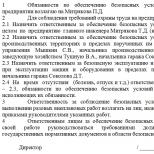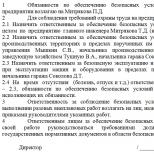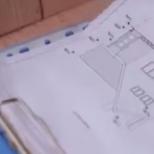Fern spores 5 letters scanword. Higher spore plants: ferns. Word definitions for sorus in dictionaries
Kingdom: plants
higher spore plants
Supersection: ferns
Department: ferns
Department: Lycopsoid
Department: horsetail
General characteristics of ferns
- They originated in the Devonian. They reached their biological flowering in the Carboniferous, becoming the main forest-forming group. The remains of the forests have formed vast deposits of coal.
- The largest number of species in the tropical zone.
- They prefer moist habitats, because male gametes are mobile, and moisture is needed to move the sperm to the egg.
- There are tissues and organs.
- The life cycle is dominated by the diploid sporophyte.
- Reproduction is sexual and asexual (sporulation).
- The organs of sexual reproduction are multicellular.
Division Ferns
Currently, the department has approximately 12,000 species.
Life forms: grasses, trees (Fig. 1) and creepers (several tropical species). There are water forms, for example, salvinia floating (Fig. 2).

Rice. 1 Fig. 2
fern leaves - fronds- whole or complexly dissected with a well-developed conduction system. The development of the leaf comes from the "snail" (Fig. 3).
Leaves can be differentiated into sterile and fertile, for example, in the ostrich (Fig. 6), have a sterile and fertile part (leaf, Fig. 4) or perform both functions simultaneously (most ferns, Fig. 5). The fertile leaves of the ostrich do not photosynthesize.



Rice. 3 Fig. 4 Fig. five
Most ferns have an underground rhizome and well-developed adventitious roots (Fig. 7).


Rice. 6 Fig. 7
The life cycle of ferns includes the alternation of a haploid gametophyte and a diploid sporophyte with a predominance of the sporophyte. In the life cycle, there is an alternation of sexual and asexual reproduction (Fig. 8).

During asexual reproduction, paired outgrowths are formed on the underside of the leaf - sori(Fig. 9). The sorus is a stem and a veil that covers the bottom of the spherical sporangia (Fig. 10), extending from the base of the stem. In sporangia, spore mother cells are formed, which divide by meiosis to form haploid cells that become spores. In dry weather, the edges of the spathe are folded back, and the sporangium shell bursts due to uneven thickening of the walls of the cells that form it.


Rice. 9 Fig. 10
From spores that have fallen into a moist, lit place, a haploid fern gametophyte develops - sprout- in the form of a heart-shaped plate with numerous rhizoids. On its lower side, antheridia with spermatozoa and archegonia with eggs are formed. Like mosses, ferns need water to thrive. On it, polyflagellated fern spermatozoa swim to archegoniums. There, the sperm fuse with the egg, forming a diploid zygote. A new diploid plant grows from it.
In the forests of the temperate zone, the most common are the male boletus, the female boletus, and the bracken.
Department of Lycopods
- The shoot is creeping, dichotomously branching.
- leaflets (phylloids)small simple with one central vein.
- Reproduction is sexual and asexual (sporulation).
- The life cycle is dominated by the diploid sporophyte.
The representative of the club mosses, often found in our country, is the club moss (Fig. 11).

In the life cycle of club mosses, like all ferns, there is an alternation of sexual and asexual reproduction (Fig. 12). At the ends of the shoots of the club moss, erect spore-bearing spikelets- strobili. Spore-bearing spikelets are covered with modified scaly leaves - sporophylls- on which sporangia are formed. In sporangia, meiosis produces haploid spores. Mature spores spill out, and a haploid outgrowth develops from them. In many species of club moss, the growth develops underground for several years, feeding heterotrophically, mainly due to symbiosis with the fungus. On a mature gametophyte, archegonia with eggs and antheridia with spermatozoa are formed. After fertilization, the zygote develops into a diploid sporophyte, which feeds on the gametophyte until it reaches the ground, where it begins to photosynthesize.

Horsetail department
An ancient group of vascular plants, currently represented by about 30 species.
The stems are hollow, consisting of individual segments and performing the function of photosynthesis (Fig. 13). To increase strength, bundles of sclerenchyma fibers pass under the epidermis, forming ribs on the surface of the stem. In addition, small silica crystals are deposited in the stems of horsetails, which increase their rigidity.
Under the ground, horsetail forms a dense network of rhizomes that serve for vegetative reproduction and winter survival.

In the spring, spore-bearing shoots grow out of the ground. They are brown in color because they do not contain chlorophyll and live off the nutrient reserves accumulated last year. On their sporophylls, as a result of meiosis, haploid spores are formed, which have special filamentous outgrowths that change shape depending on humidity. This allows them to leave the sporangium more easily and spread more widely. They give rise to a haploid outgrowth. The life cycle of horsetails is similar to life cycle ferns (Fig. 14).
Total found: 3, by mask 5 letters
fern, the young shoots of which are used as food in Korea and the Far East
genus of ferns in the family Cyathaeaceae
fern or stingray
a group of spore-bearing organs that have not fused with each other - sporangia, located on the underside of the leaves of most ferns
a collection of closely spaced reproductive organs, sporangia, formed on the underside of a leaf of ferns and some algae
Set of fern spores, 5 letters, 5 letter "C", crossword puzzle
5 letter word, first letter is "C", second letter is "O", third letter is "R", fourth letter is "U", fifth letter is "C", word with letter "C", last letter "C" ". If you do not know a word from a crossword puzzle or a crossword puzzle, then our site will help you find the most difficult and unfamiliar words.
Guess the riddle:
Union, number then pretext - That's the whole charade. And so that you can find the answer, You need to remember about the rivers. Show answer>>
The flower was sleeping and suddenly woke up - I didn’t want to sleep anymore. Moved, startled, Soared up and flew away. Show answer>>
First shine, followed by crackling, followed by splashing. Show answer>>
Other meanings of this word:
Random riddle:
Not a gem, but glowing.
Random joke:
A man approaches an ice cream stand and addresses the saleswoman:
— I, please, chocolate and pistachios.
— Sorry, but the pistachios are already over.
- Then let's have strawberries and pistachios.
- I told you that the pistachios are already over!
— Then some pistachios.
Scanwords, crosswords, sudoku, keywords online
A collection of closely spaced reproductive organs, sporangia, that form on the underside of the leaf of ferns and some algae
The last beech is the letter "s"
Answer for the question "A set of closely spaced reproductive organs, sporangia, formed on the underside of a leaf of ferns and some algae", 5 letters:
sorus
Alternative questions in crossword puzzles for the word sorus
A group of spore-bearing organs that have not fused with each other - sporangia, located on the underside of the leaves of most ferns
A group of non-fused spore-bearing organs on fern leaves
Word definitions for sorus in dictionaries
Encyclopedic Dictionary, 1998 The meaning of the word in the dictionary Encyclopedic Dictionary, 1998
SORUS (from the Greek soros - a bunch) is a group of spore-bearing organs that are not fused with each other - sporangia, located on the underside of the leaves of most ferns.
Great Soviet Encyclopedia The meaning of the word in the dictionary Great Soviet Encyclopedia
(from the Greek sorós ≈ heap), a group of crowded reproductive organs ≈ sporangia (for example, in ferns, zoosporangia ≈ in brown algae kelp), oogonia (for example, in brown algae dictyota).
Wikipedia The meaning of the word in the Wikipedia dictionary
Sorus - a group of crowded spores or organs of asexual reproduction - sporangia or gametangia on the surface of the thallus in red and brown algae, on the leaves of ferns, as well as a group of fruiting bodies in lower fungi.
Examples of the use of the word sorus in the literature.
Then their eyes met, and the boy, smoothing over the awkwardness, finished: - No, Sorus I'm no longer a child.
Source: Maxim Moshkov Library
fern moss algae
Bracken, whose young shoots, when skillfully cooked, resemble in taste the best views mushrooms.
The novel by the American writer Philip Bonoski "Magical. ".
A plant that blooms on the night of Ivan Kupala.
A plant that blooms, according to legend, on the night of Ivan Kupala.
Poem by V. Bryusov.
fern fern
FROND
Large fern leaf.
treasure
What, according to ancient Russian beliefs, can be found with the help of a fern?
Treasure (cartoon) Treasure Treasure Treasure Treasure
5 letters
ORLYAK
Type of fern.
Orlyak Orlyak
SORUS
A collection of closely spaced reproductive organs, sporangia, that form on the underside of the leaf of ferns and some algae.
SPORE
Fern in infancy.
Azolla
FLOWER
Drama by a Lithuanian poet of the 20th century. Ludas Gere. fern".
Flower
CYATEA
Type of tree ferns.
ONOCLEA
A genus of fern that includes many tropical species.
ASPIDIUM
Shield, the generic name of ferns from the family Polypodia.
ZAROSTOK
Sexual generation (gametophyte) in horsetails, club mosses, ferns and selaginella.
LISTOVIK
MEGAFILL
A leaf of a fern or seed plant derived from a dense system of branches (thalli) of ancestral groups of primitive higher plants.
ARCHEGONIUM
The genital organ of mosses, ferns, etc.
PROTHALLIUM
Sexual generation (gametophyte) in ferns, horsetails, club mosses, selaginella.
SPOROFILL
Leaf of fern-like plants, on which sporangia with spores develop.
POLYPODIUM
Type of fern.
11 letters
ARCHEOPTERIS
The oldest large fern-like plant that existed from the Devonian to the Carboniferous.
SCOLOPENDRIUM
A genus of ferns in the Aspleniaceae family.
Collection of fern spores letters 5
The answer to the scanword or crossword puzzle to the question: bacteria
phage(bacteriophages), - viruses bacteria that can infect a bacterial (infected) cell, multiply in it and cause its lysis (destruction) Used in the treatment - phage therapy of infectious diseases
Pus Contains proteins, decaying white blood cells, bacteria and tissue breakdown products
Kvass Kvass acid kills pathogenic bacteria, cleanses the body, gives strength
Phages- Viruses that infect bacteria
Flu Streptococcus pneumoniae, Haemophilus influcnzae, and Staphylococcus aureus are the main bacteria causing secondary infection in humans, and appropriate antibiotic therapy is used to suppress them.
Kefir Invisible to the eye, bifidobacteria bring quite tangible benefits to the body, regulating its numerous functions.
Cashew Japanese teachings in the course of scientific experiments have established that the substances contained in cashews can kill bacteria that destroy tooth enamel
Dogwood Due to the content of phytoncides, berries have a detrimental effect on typhoid, dysentery and some other bacteria.
cocci Cocci are unicellular spherical bacteria
Leprosy(leprosy), Hansen's disease is a chronic disease caused by bacteria of the species Mycobacterium leprae; these bacteria infect the skin, mucous membranes and nerves in the human body
Lemon It destroys bacteria, effective against viruses and fungal infection, reduces the risk of infection
Radish It removes pathogens from the body: bacteria, microscopic fungi and other "protozoa"
Aerobes Obligate, or strict, Aerobes develop only in the presence of oxygen (for example, acetic acid bacteria); facultative, or conditional, aerobes - and at its slight concentration (for example, yeast).
Yogurt If yogurt can be stored at room temperature for several months, then it is unlikely to have “live bacteria” preserved in it.
Cactus A variety of cactus spotting causes viruses and bacteria when conditions are violated
Clover Root nodules are formed on small roots, containing nodule bacteria that absorb atmospheric nitrogen, which increases soil fertility.
Cranberry If you drink antibiotics with cranberry juice, but only natural, without additives, their effect will increase! Also, cranberries have a unique ability to first collect the pathogenic bacteria in the body, and then “take away” them, just as the flutist-rat-catcher took the rats from Hammeln
Cucumber Bacteria - causative agents of bacteriosis - are stored in plant debris and spread through seeds
Passage Grafting bacteria from one animal to another
Smegma In smegma, bacteria that are harmless to the body multiply rapidly, which in their own way appearance reminiscent of tubercle bacillus
Cystitis Why does cystitis occur? Inflammation of the bladder can be caused by infections and invasions (bacteria, viruses, fungi, protozoa and ... even worms), stones and foreign bodies, general endocrine diseases and menopause, physical and chemical factors, oncological diseases, and even some drugs
bacilli- rod-shaped bacteria that form spores
Legumes Nodule bacteria live on the roots of legumes.
Bronchitis Please note that this often happens to those who suffer from not acute, but chronic bronchitis, because infectious exacerbations of this disease can provoke both viruses and bacteria
Vacuole When leukocytes phagocytize bacteria and other foreign particles, vacuoles form in their cytoplasm.
Microbes- the general name of microscopically small organisms, which include bacteria, actinomycetes, yeasts, some fungi and unicellular protozoa
Phagocyte(phagocyte) - a cell capable of absorbing bacteria, protozoa, other cells and their remains, as well as various small particles
episome(epi- + (chromo)some) - genetic structure of a bacterium, which is a deoxyribonucleic acid molecule capable of independent existence (and reduplication) in the cytoplasm, as well as reversible incorporation into the bacterial chromosome
They are located on ordinary leaves (fronds), mainly with reverse side, in others - on special spore-bearing fronds differing in structure. How to sow ferns?
When to sow fern spores
If the sori darken, then the spores are ripe. Take the vayu and put it in a paper bag. After a while, the bag will contain a dried fern leaf and a bunch of spore powder. For most ferns, it doesn't matter when they are sown. Although there are exceptions: controversy Osmund germinate only when sown freshly harvested. It is also better not to delay the sowing of the rest: germination, although slowly, falls, and the germination of stale spores is delayed. Fresh spores germinate in about a week or two.
Taking into account the fact that it takes up to two months for the formation of seedlings, then the same amount for the development of roots, many authors advise sowing in autumn or early winter, and then fern seedlings will develop by the end of winter-early spring.
5 letter word, first letter is "C", second letter is "O", third letter is "R", fourth letter is "U", fifth letter is "C", word with letter "C", last letter "C" ". If you do not know a word from a crossword puzzle or a crossword puzzle, then our site will help you find the most difficult and unfamiliar words.
Guess the riddle:
Although I'm not a hammer - I knock on wood: Every corner in it I want to examine. I walk in a red hat And a beautiful acrobat. Show answer>>
Do you want me to show you a trick? I keep snow on a stick! I ate the snow, what a pity Only the stick remained. I ate snow, cheered up And didn't get sick at all. Show answer>>
Skinny girl - Stiff bangs, Cools down during the day. And in the mornings and evenings Work is accepted: He will cover his head, Yes, he will wash the walls. Show answer>>
Other meanings of this word:
Random riddle:
A worker lives in the forest - a forest nosy carpenter.
Random joke:
Schmulberg, the owner of a nail business, calls his son and says:
- Izya, I want to temporarily entrust you with the management of the company: I have been working without rest for so many years that I finally need to rest. I'm leaving for 3 months in the Bahamas and I want you to manage the company all this time, solve all the problems and not bother me.
Schmulberg leaves for the Bahamas, rests there in full, but suddenly a month later his son calls him:
- Dad, I advertised - and now the nails are spreading so that the production can not cope - and I do not know how to manage the production, so you need to come help me!
The next day, Schmulberg arrives home and asks his son:
- Izzy, how did you manage to set up sales like that.
- It's very simple: I gave an advertisement. Won! Do you see the poster hanging on the wall?
Schmulberg looks at the poster - and sees that it depicts Christ crucified on the cross, and at the bottom there is an inscription: "Schmulberg's nails - thanks to them he has been holding on for 2000 years!". Schmulberg:
- Izzy, what did you do. Take down all these posters now, and remember: never use the name and image of Jesus Christ in advertising! Do you want the pogroms to start again?!
After that, Schmulberg again leaves for the Bahamas. A month later, the son calls him again:
“Dad, I changed the ad, the nails are still spreading, production is running at full speed, and now I have supply problems. So you need to come back.
Schmulberg returns to his city - and his son shows him new advertisement- a poster that shows an empty cross, and at the bottom the inscription: "Schmulberg's nails should have been used!".
Did you know?
Human heart: per day, the heart pushes 6 tons of blood.
Scanwords, crosswords, sudoku, keywords online
Total found: 2, by mask 5 letters
sorus
a group of spore-bearing organs that have not fused with each other - sporangia, located on the underside of the leaves of most ferns
a collection of closely spaced reproductive organs, sporangia, formed on the underside of a leaf of ferns and some algae
The last beech is the letter "s"
Answer for the question "A set of closely spaced reproductive organs, sporangia, formed on the underside of a leaf of ferns and some algae", 5 letters:
sorus
Alternative questions in crossword puzzles for the word sorus
A group of spore-bearing organs that have not fused with each other - sporangia, located on the underside of the leaves of most ferns
A group of non-fused spore-bearing organs on fern leaves
Pupyrka on a fern
Word definitions for sorus in dictionaries
Encyclopedic Dictionary, 1998 The meaning of the word in the dictionary Encyclopedic Dictionary, 1998
SORUS (from the Greek soros - a bunch) is a group of spore-bearing organs that are not fused with each other - sporangia, located on the underside of the leaves of most ferns.
Great Soviet Encyclopedia The meaning of the word in the dictionary Great Soviet Encyclopedia
(from the Greek sorós ≈ heap), a group of crowded reproductive organs ≈ sporangia (for example, in ferns, zoosporangia ≈ in brown algae kelp), oogonia (for example, in brown algae dictyota).
Wikipedia The meaning of the word in the Wikipedia dictionary
Sorus - a group of crowded spores or organs of asexual reproduction - sporangia or gametangia on the surface of the thallus in red and brown algae, on the leaves of ferns, as well as a group of fruiting bodies in lower fungi.
Examples of the use of the word sorus in the literature.
Then their eyes met, and the boy, smoothing over the awkwardness, finished: - No, Sorus I'm no longer a child.





